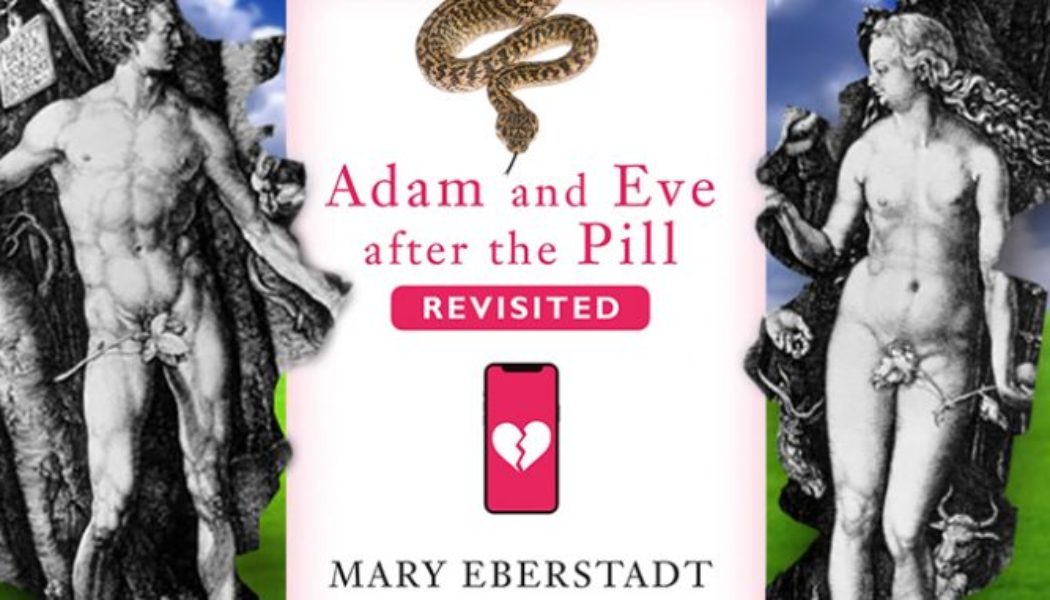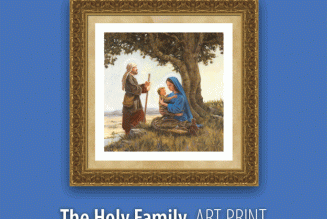
The so-called “sexual revolution” has wreaked havoc on the foundations of our society. Some of the most fundamental building blocks of day to day life – sex, procreation, marriage, family – are under attack, and the consequences of this attack are becoming clearer and clearer with time. Mary Eberstadt has once again poised her pen to analyze and diagnose these issues, and provide a roadmap for the future.
Eberstadt is the author of several books, including Adam and Eve after the Pill: Paradoxes of the Sexual Revolution, How the West Really Lost God, and The Loser Letters, and was a contributor to the collection Why Humanae Vitae is Still Right.
Her most recent book is Adam and Eve after the Pill: Revisited (Ignatius Press, 2023). Here she continues her examination of the legacy of the sexual revolution, exploring and dissecting the fallout that has infected society as a result. Specifically, this follow-up volume looks at how society, politics, and Christianity have fared in the decades since the sexual revolution’s genesis. A timely book, it also looks at the Dobbs decision of the Supreme Court, which overturned Roe v. Wade and Planned Parenthood v. Casey.
Eberstadt recently spoke with Catholic World Report about her latest book, the wages of the sexual revolution, and hope for the future.
Catholic World Report: How did the first Adam and Eve after the Pill book come about? And what’s the relationship between that first volume, published a decade ago, and the new Adam and Eve after the Pill, Revisited?
Mary Eberstadt: Adam and Eve after the Pill argued that contrary to today’s dominant script, the sexual revolution has exacted a steep toll. For many years, evidence about the downsides of post-revolutionary life has been accumulating across social science. Adam and Eve after the Pill collected and deployed some of those facts to advance a revised, counter-cultural view of the post-1960s order. It documented what might be called the “microscopic” fallout of the revolution – its negative effects on individual men, women, and children.
The second volume, Adam and Eve after the Pill, Revisited, continues the contrarian case by widening the aperture. It examines the “macroscopic” consequences in three spheres: politics, society, and the Church itself. Revisited does not mean “revised.” This isn’t an updated edition of the first book. It’s a new book, a new round of research demonstrating how postrevolutionary mores continue to transform the West – including its churches.
CWR: Readers might be interested to know the backstory of Cardinal George Pell’s Foreword to the book, especially given his sudden passing following surgery last month. Anything to share?
Eberstadt: After the first book’s appearance, the late, great, Cardinal Pell kindly took an interest in its thesis. So last year, as I was writing Adam and Eve after the Pill, Revisited, the Cardinal was asked if he would consider adding some thoughts to this successor. Magnanimously, he read the manuscript, and contributed its Foreword.
I’m eternally grateful to have Cardinal Pell’s wisdom included in these pages. He was courage and faith personified, a magisterial soul of the first order.
CWR: Our society is facing issues that no one could have predicted we would ever have to face, even a few years ago. Why is society’s understanding of the most fundamental building blocks (marriage, parenthood, sexuality, gender, etc.) in such a sorry state?
Eberstadt: Thanks to the compounding fractures of six decades, many people today are in parlous shape. This is simple arithmetic. Families are smaller; families are broken; many people no longer have siblings of the same sex, or of the opposite sex, or any siblings at all; abortion continues; more and more kids are growing up without a father: in sum, post-revolutionary man has subtracted potential trusted souls out of his life on an unprecedented scale.
Inadvertently, but really, this means a diminished pool of loved ones to count on. It means fewer people to trust and learn from. Rudimentary social learning is harder to come by. The differences between men and women, the meaning of marriage, the sanctity of motherhood and fatherhood: more and more people lack the vocabulary for such foundational concepts. Post-revolution, the route to fulfillment and joy has become elusive. It must be laboriously rediscovered or re-invented by people who have been deprived. And the reinventions often don’t work.
Questions of identity now haunt the West. Many can no longer answer that question, Who am I?, by reference to the horizontal coordinates of family; or to the vertical coordinates of relationship to God and faith. As documented throughout Adam and Eve after the Pill, Revisited, one consequence of that primordial loss is social deterioration.
CWR: In the decade since Adam and Eve After the Pill was first published, has the societal trauma caused by the sexual revolution accelerated?
Eberstadt: Absolutely.
After all: evidence abounds that something about post-revolutionary life is inflicting damage. Psychologists cite an unprecedented mental health crisis among young people. Also at record levels: psychotropic meds for adults, licit and illicit. Across the United States, drug overdoses are higher than they have ever been, and life expectancy is declining.
Meanwhile, atomized, broken children take to the streets in gangs, or as solitary shooters, proving that loneliness fuels evil. “Deaths of despair” — a phrase that did not even exist when the first Adam and Eve book appeared – has entered the vernacular.
This tragic recital points to causality. The sexual revolution is not the only force contributing to today’s dysfunction. But it is the single most important cause of social disintegration that is not yet understood as such. The hope behind both Adam and Eve books is to change that misperception, to correct the record for the benefit of people present and to come.
CWR: What sort of reaction did you get to the book after its initial publication in 2012?
Eberstadt: Within religious circles, including non-Catholic circles, Adam and Eve after the Pill was roundly discussed. Across secular media, its appearance went mostly unnoticed. That wasn’t a shock. Protection of the revolution is central to today’s anti-Christian and a-Christian secularist faith. Until recently, questioning its legacy has been practically verboten.
What did surprise, as detailed in the new book’s Introduction, was the emotional reaction among readers. Often, after a public talk or other engagement, listeners would come forward to share painful details of their lives. Correspondents did the same by e-mail or in publications. These often-raw testimonies seemed potent confirmation of the book’s point: the lives of many Western men and women have been transformed by contraception, abortion, family breakup, and the rest; and there’s a pent-up demand among sufferers to put a name to all that.
CWR: Are you optimistic about the future of our society? Is there a light at the end of the tunnel?
Eberstadt: Ironically, researching and writing both books strengthened my conviction that revisionism about the post-1960s status quo is on the way.
During the past couple of years, as detailed in the new book’s footnotes, non-religious writers from different countries have arrived at the same conclusion reached by Adam and Eve after the Pill: the revolution’s sacrosanct status is overdue for skeptical inquiry. A decade ago, such voices were non-existent. Their emergence means that the kind of evidence cited in both Adam and Eve books has become harder to ignore – and that ultimately, it will make a dent.
CWR: What do you hope readers will take away from the book?
Eberstadt: First, that they’ll be inspired by a truth reiterated in both volumes: traditional Christian teaching is being tacitly, yet fully, vindicated by sources outside the Church. More and more, empirical analyses underscore the wisdom of that tough but luminous rule book.
Those are bracing facts. Believers everywhere can summon courage from them.
I also hope that readers of faith will find the chapters on Christianity helpful. They are meant to explain what many already sense: the churches today are plagued by civil war. And the conflict isn’t over the Beatitudes or the Creed or angels on pins. It’s about who, exactly, sets the rules concerning sex: Church teaching of two thousand years’ standing; or the secularist world re-drawn by the Pill, insistent on post-revolutionary prerogatives.
One camp wants to accommodate the revolution, in whole or in part. The other camp believes that experiment has been tried repeatedly, and repeatedly failed. Whichever side prevails will definitively shape the Church of tomorrow.
CWR: Is there anything else you would like to add?
Eberstadt: There’s no better last word than Cardinal Pell’s. As the final sentence of his Foreword summarizes elegantly: “The chaos should be named and shamed, while Christians continue to show that they will not abandon those who have been abandoned, offering them instead healing and friendship and the Good News of the one true God’s great love for us.”
If you value the news and views Catholic World Report provides, please consider donating to support our efforts. Your contribution will help us continue to make CWR available to all readers worldwide for free, without a subscription. Thank you for your generosity!
Click here for more information on donating to CWR. Click here to sign up for our newsletter.








